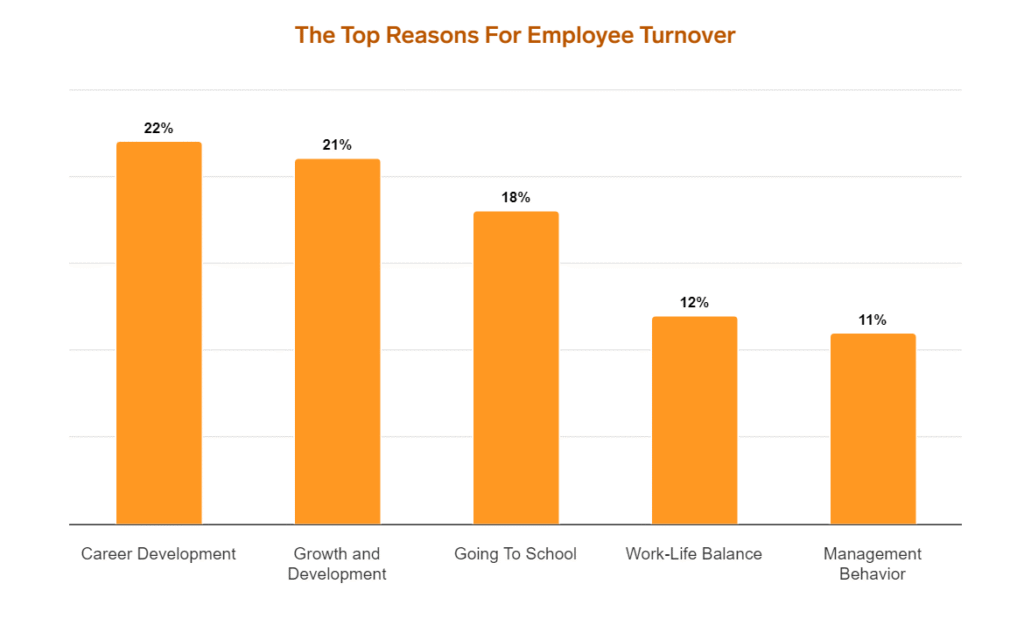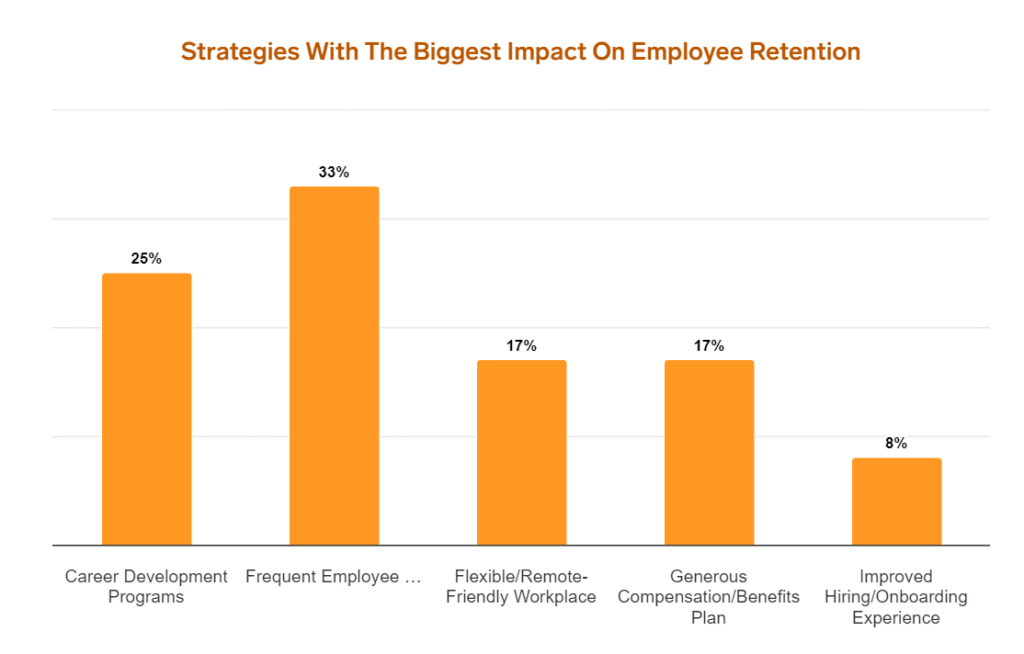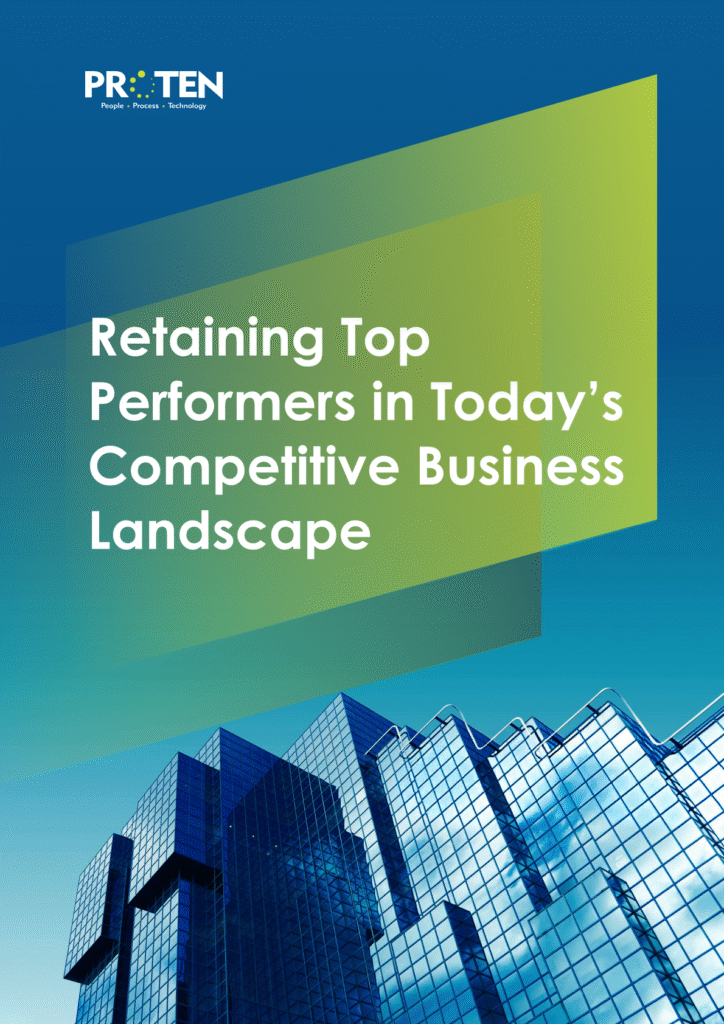In today’s competitive business landscape, the retention of top performers has become a critical priority for organizations striving to maintain a competitive edge. High-performing employees contribute disproportionately to productivity, innovation, and organizational stability, making their retention essential for long-term success.
However, evolving workforce expectations, greater mobility, human capital flight from Nigeria, and expanding global opportunities have made retaining these talents increasingly challenging.
According to a report by Jobberman, 47% of employees say they are likely to leave their employer in the next 6 months. With such a high rate of anticipated employee turnover, it is important for employers to consistently seek out practical and strategic solutions to build a culture where high performers feel valued, engaged, and motivated. to stay.
Grasping the elements that lead to low retention rates and elevated turnover is fundamental for employers in crafting successful approaches to keep their valuable workforce.
Why Do Top Performers Leave
Increased Employee Expectations
Demand for Growth and Development: According to WTW, 70% of employees say they will be forced to leave their organisation to advance their careers. Top performers prioritize career advancement and are more likely to leave if they feel growth opportunities are limited.
Work-Life Balance and Flexibility: In the post-pandemic era, employees increasingly expect flexible work arrangements and a culture that values work-life balance. This fact is confirmed by 95% of HR leaders who admitted that employee burnout is sabotaging workforce retention, according to a study by Kronos.
Recognition and Engagement: High performers often expect frequent recognition for their contributions. Studies show that 79% of people who quit their jobs cite “lack of appreciation” as their reason for leaving. A lack of engagement and acknowledgment can lead to disengagement and dissatisfaction.
Competitive Talent Market
Global Talent Mobility: There are three times more remote jobs now compared to 2020. Remote work and digital collaboration have increased employees’ access to global opportunities, making it easier for top talent to transition to other organizations outside their local environments.
Rising Competition for Skills: Industries experiencing rapid technological evolution have a growing demand for specialized skills, increasing the competition for high performers.
Evolving Organizational Culture Expectations
Desire for Purpose and Values Alignment: According to TINYpulse, employees who believe that their company has a higher purpose than just profits are 27% more likely to stay at their companies. Top performers value companies that align with their values and purpose. A misalignment between personal and organizational values can drive employees to seek opportunities elsewhere.
Need for Strong Leadership and Vision: Leaders who can effectively communicate a vision, inspire their teams, and provide support are critical to retention. According to Udemy, nearly half of employees said they’ve quit a job because of a bad manager. Poor leadership contributes to a lack of trust and low morale, pushing high performers to exit.

Source: FlairHR
Consequences of High Attrition Rate Among Top Performers
Financial Impact: According to Gallup, losing and replacing a trained employee can cost an organization up to 200% of the employee’s salary. When recruitment fees, training, and lost productivity are considered, a high turnover rate among top performers can have crippling financial implications for a business.
Operational Disruptions: High attrition rates, especially among high-performing individuals will often lead to workflow interruptions, knowledge gaps, decreased morale among remaining staff, and strained client relationships, creating operational instability and loss of productivity.
Strategies for Retaining Top Performers
Foster Career Development and Growth Opportunities
LinkedIn’s 2018 Workforce Learning Report revealed that 93% of employees would stay at a company longer if it invested in their careers. Implementing a structured career progression framework with clear advancement paths and skill development opportunities will play a vital role in retaining top performers.
Findings by TINYpulse reveal that employees who feel they’re progressing in their careers are 20% more likely to keep working in their company in the next year. Employers can offer regular feedback, personalized development plans, and stretch assignments that allow employees to grow within their roles and achieve long-term career goals within the organisation.
Enhance Work-Life Balance and Offer Flexible Working Arrangements
Work-life balance and flexible working arrangements are increasingly becoming crucial career considerations among top professionals. Employees who rate their work-life balance highly are 10% more likely to stay at their company.
Proactive measures towards enhancing work-life balance include adopting flexible work models, including hybrid or remote work options, and offering resources for employee wellness, such as mental health support, flexible hours, and paid time off.
These policies can be successfully implemented while ensuring accountability for deliverables. Companies that provide remote working options have been shown to experience 25% lower attrition rates according to a report by Gallup.
Provide Meaningful Recognition and Reward Programs
According to TINYpulse data, 21.5% of employees that don’t feel recognised when they do great work have interviewed for a job in the last three months, compared to 12.4% that do feel recognised. It’s important to establish a recognition program that regularly acknowledges and rewards employees’ contributions, particularly those of top performers.
Recognition can be formal, such as performance bonuses, or informal, such as public praise and spot awards. Informal recognition can also be very effective as seen in a report by Qualtrics which showed that employees whose managers consistently acknowledge them for good work are five times more likely to stay at the company.
Create a Culture of Purpose and Values Alignment
Creating a sense of purpose within an organisation will help your employees feel like they are doing something meaningful. Gallup research found employees who are “engaged and thriving” doing meaningful work are 59% less likely to look for a job with a different organisation.
Organisations can create a sense of purpose by ensuring that the mission, vision, and values are clearly communicated and authentically practiced. This creates a work environment where employees see the impact of their work and feel connected to the organization’s larger purpose.
Invest in Leadership Development
According to a TINYpulse Employee Retention Report, 40% of employees who don’t rate their supervisor’s performance highly have interviewed for a new job in the last 90 days, compared to just 10% for those who do rate their supervisor highly.
In addition to working with the organisation, employees also work with their managers. It is therefore imperative to equip managers with the right training and tools to support, inspire, and effectively manage high performers. Great managers know how to recognize their team’s achievements, provide constructive feedback, and cultivate a supportive work environment.
Offer Competitive Compensation and Benefits
Money isn’t everything when making career decisions; however, competitive salaries and desirable benefits are critical factors when trying to retain top performers. According to a report by the Conference Board, a 20% increase in salary would entice nearly half of the workforce to consider changing jobs.
Benchmarking compensation and benefits against industry standards is vital to ensure they are competitive. While salary alone is not enough to retain talent, inadequate pay is a primary driver for turnover.

Source: FlairHR
Retention Success Metrics
Retention Rates of Top Performers: Track retention rates specifically for high-performing employees to evaluate the impact of the initiatives.
Employee Engagement Scores: Use engagement surveys and pulse surveys to gauge employees’ sense of purpose, satisfaction, and alignment with the organization’s goals.
Performance and Productivity Metrics: Assess the impact of retention efforts on productivity, such as project completion rates, customer satisfaction scores, and innovation metrics.
Cost-Benefit Analysis: Compare the costs of implementing retention programs against turnover costs, demonstrating how reduced turnover leads to savings and improved outcomes.
Conclusion
According to Gallup, a greater retention rate among high-performers can potentially boost a company’s profits by up to four times. Retaining top performers requires a strategic approach that addresses their unique expectations and aligns with organizational goals. By creating a supportive environment with opportunities for growth, recognition, and flexibility, organizations can build a culture that motivates high performers to stay and thrive. Investing in retention efforts is an investment in the organization’s future, driving sustained growth, innovation, and competitive advantage.

